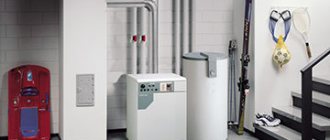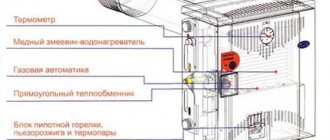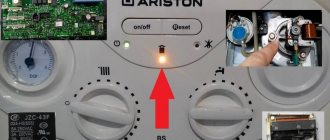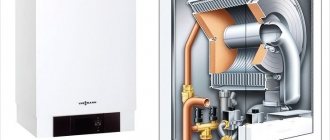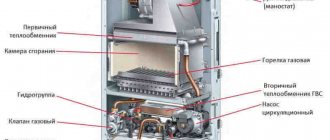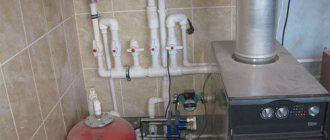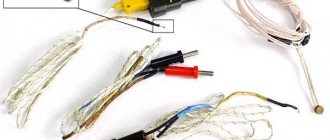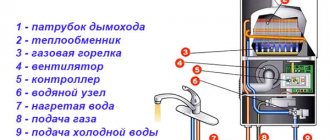It may be news to some that gas boiler equipment requires not only gas, but also electricity. And along with gas consumption, you should also take into account the power consumption of the gas boiler, which is the heart of your heating system.
Now there will definitely be a reader who will object and be right. But he is right in that there are still gas boilers without connection to the electrical network. These are classic floor-standing units with an open combustion chamber; they require a separate room and strict adherence to strict fire safety rules in it.
Non-volatile boilers are currently used in villages remote from cities, in dachas - where there are interruptions in the electricity supply. Or if you want to save on buying equipment. We will talk about modern gas heating equipment, and it only works if there is a high-quality, reliable power supply.
What does electrical power mean?
The operating manual for a gas boiler contains information about the amount of energy required to fully implement the functionality of the unit.
The power supply requirements indicate the power consumed from the network, expressed in W or kW.
There are no standards that regulate what information the manufacturer must include in the accompanying manual.
Therefore, information about power consumption is indicated in an arbitrary manner:
- total maximum power when all devices are turned on;
- electricity consumption in one or more modes and in any other combinations;
- value for each node separately (pump, ignition, fan, protection, sensors).
Thus, electrical power is the amount of work produced per unit of time.
How to find out how many kilowatts per day a gas appliance consumes
To find out how much electricity a gas boiler consumes, you need to do a regular calculation of energy consumption - it is used for any electrical appliances.
For the calculation, you will need the value of the electrical power of the boiler. Its value is indicated in the technical documentation; it is measured in watts (W or W) and kilowatts. Usually they indicate the maximum value of kilowatts consumed by the device - it significantly exceeds the average.
Let's say we have a Baxi Eco Four 24 double-circuit heater, its heating capacity is 24 kW, and its electric capacity is 130 W. To calculate daily electricity consumption, you need to multiply the power consumption by the number of hours during which consumption occurs.
If energy is consumed around the clock: 130 W x 24 hours = 3120 Wh
This is the maximum consumption of the Baxi Eco Four 24 model per day. Dividing the result by 1000, we get 3.12 kWh. To find out how many kWh the device consumes per month - and it is in these units that the consumed electrical power is indicated in payment receipts - you need to multiply the number of kilowatts consumed per day by 30:
3.12 kWh x 30 (days) = 93.6 kWh
This is the maximum value of consumed electrical power. It is clear that to calculate consumption for a year, you need to multiply the result by the number of months in a year during which the device operates.
For single-circuit models, their number is limited by the heating season - about 5. For dual-circuit devices switched to economical summer mode, consumption is calculated taking into account the summer months.
What is electricity used for?
In heating equipment connected to electrical networks, the lion's share of electricity is consumed:
- Circulation pump. It “eats” electricity more than others and consumes energy up to 200 watts per hour. Like any electric motor, the pump requires impeccable voltage parameters. Any non-compliance with the standards leads to a decrease in power indicators - it begins to work noisily and may even break down.
- Protective automation. It consumes little electricity - about 15-30 W. He is afraid of changes in the power supply - because of them, the controller may break, which will cause the equipment to turn off.
- Burners. They are extremely demanding on current characteristics. They require a three-pole connection so that the fire is recognized by the ionization electrode and the burner does not stop operating. Gas burner devices are characterized by a long starting current of the fan - the starting power increases. The fan motor is sensitive to the parameters of the electrical network - even with the smallest deviations from the correct sinusoid, it operates unstable.
Factors affecting electricity consumption
The equipment of a gas boiler with additional devices directly affects the level of energy consumption.
The main costs come from the following components:
- Circulation pump with power from 20 to 150 W. The exact value is determined by the operating mode (constant or switched), as well as the technologies and materials used, such as a magnetic rotor, a carbon fiber impeller, the use of a frequency converter, and an electronic performance control unit.
- Turbine consuming from 10 to 80 W. The exact value is determined by the volume of required gas exchange, the efficiency of the automatic component, the weather, and the boiler power.
- The burner and electric ignition make a small contribution, with the exception of the short moment of starting the boiler, when the power consumption increases to 100 W.
- Automatic control and regulation sensors. Despite the constant operating mode, they make a small contribution to energy consumption - up to 10-15 W.
Technical characteristics
Let's look at the boiler parameters, presented for convenience in table form:
| Characteristics | Meaning |
| Power | 24 kW |
| Heated area | 240 m2 |
| Dimensions | 730 : 400 : 299 mm |
| Weight | 33 kg |
| Power consumption | 10.6 kW |
| Efficiency | 92,9 % |
| Gas consumption | 2.73 m3/h |
| Exhaust temperature | 30-80° |
| DHW temperature | 35-60° |
| Allowable pressure | 19.1 bar |
| Chimney | Coaxial 60/100 mm |
| Power supply | 230 V, 50 Hz |
Is it possible to reduce the electricity consumption of a gas boiler?
The later heating equipment is released, the higher its energy efficiency, even with an expanded set of functions. Otherwise, it is only possible to radically reduce electricity consumption by completely updating the installation.
The following methods are also used:
- reduction of operating time of electrical components;
- saturation of the heating system with control sensors that will maintain the minimum required operating time;
- disabling unused functions;
- replacing obsolete components with new ones that have greater efficiency;
- reducing the number of boiler shutdown and ignition cycles;
- transfer (programming) of equipment to “quiet” operation with a smooth change in the temperature of the medium while installing a heat accumulator;
- controlling the performance of the circulation pump using a set of temperature sensors and room thermostats;
- introduction of remote monitoring and control methods.
The reduction in electricity consumption can be carried out to a certain threshold, after which the system will not be able to maintain a comfortable temperature in the rooms. In this regard, there is no need to abuse savings on relatively small, up to 150-250 W, power consumption.
Measures to reduce electricity costs should be additional, auxiliary in nature.
How to choose the most economical model?
Of the three existing models of electric boilers, the most widespread are cathode and heating element boilers. Of these, ionic ones are considered the most economical. Their efficiency reaches 98%, so the use of such models in a two-pipe heating system will give an economic effect of at least 35%, compared to other electrical devices.
Achieving such results is possible not only because of the method of energy transfer, but also because of the entire operating principle of the device. In a heating system that is configured correctly, the cathode apparatus starts working with less than 50% power.
Experts recommend choosing exactly this model of electric boiler for a private home.
Why do you need to install a UPS?
When there are interruptions in the electrical network, the well-functioning algorithm for the functioning of heating equipment is disrupted. Operation in emergency mode leads to additional costs, threatens the breakdown of expensive components and even freezes the entire system. To prevent adverse consequences, you should provide electricity from a backup source, such as a UPS.
Criterias of choice
An important factor is the availability of free space. It is more difficult to provide power to a wall-mounted unit in a small kitchen. The easiest way to place a floor-standing unit is in the boiler room.
Selecting a power source for a heating system always begins with determining the required electrical power and the duration of its expected emergency shutdown.
You cannot use UPS designed for computer equipment, since they do not produce the sinusoidal voltage required for analog devices - fans and pumps. Also, these pulse devices are designed to stabilize voltage for a short period of time, while UPS heating systems must provide several hours of operation or more.
Among the latter, the best are devices with double conversion, on-line UPS. Their advantage is the shape of the output voltage, which is as close as possible to a sinusoid.
Charging time
The UPS, in addition to stabilizing the voltage, monitors the fill level of the backup battery. If the design provides for the connection of an external battery, then its capacity should be selected based on the average duration of the emergency shutdown. If the heating system consumes 200 W, then to maintain operation for 5 hours you will need a 12 V battery with a capacity of at least 80 A/h.
For longer outages, it is worth purchasing a gasoline generator. The battery charging time is not critical, since UPSs with on-line operating mode constantly check and maintain the supply of electricity in the battery.
Given
First, a few general notes to help you understand the proposed schemes:
Part of the time the boiler is idle or operates at reduced power. Its rated power is selected to match the peak energy consumption of the house, which occurs on the coldest days of winter. When the thermometer rises, the need for heat decreases;
During the thaw, the home's need for heat decreases.
To reduce non-target heat losses, the boiler heat exchanger is insulated with mineral wool or teplovol (foil insulation based on heat-resistant foamed polymer).
Having heated the water to the desired temperature, the boiler turns off the heating and waits for the coolant to cool.
Why is a power outage dangerous?
Non-volatile boilers are designed to operate without external power sources. Interruptions are not dangerous for them: the circulation pump in the systems resumes operation of the device when voltage is applied. If there is automatic ignition, the coolant will not freeze.
For complex systems, a power outage results in the inaction of automatic control and safety sensors, a violation of the logic of operation of shut-off and control valves, and water pumps.
The list of potential threats does not end there:
- In boilers with an atmospheric burner, the automatic component does not turn off the gas, the pump does not work, so overheating of the coolant, its boiling, and destruction of boiler components or pipelines are possible.
- If a breakthrough occurs inside the boiler, the flame goes out. The incoming gas has nowhere to go and begins to accumulate in the room, which can lead to a fire or explosion if the device is not regularly supervised.
- In boilers with a closed burner, the likelihood of such a development is less, but it is not completely excluded.
In this regard, before purchasing gas equipment, you should study how design solutions ensure the safety of the device, what happens to the fuel supply in an emergency, how overheating of the coolant in the boiler is prevented, etc.
What electrical requirements should you pay attention to?
Before connecting the electric boiler, you need to pay attention to the electrical requirements
- How many watts of voltage can your home's current network handle? In particular, the voltage in rural areas is not 210-230 V, but only 150-180 V. Specific types of imported boilers at this voltage may simply not start.
- What power is allocated to your series of houses or to the village in which you live. For example, if your dacha community includes 60 houses, and electricity is allocated at the rate of 5 kW per house, then in the process of installing a boiler with a power of 30 kW you will certainly have disagreements with your neighbors. How much power is allocated to your home? Modern dacha communities very often install a 10-12 kW automatic machine in order to avoid quarrels with their neighbors.
- It is worth checking the current condition of the transformer installed in your village. In some cases, it is necessary to pull certain wires for.
- Find out what powerful electrical appliances your neighbors have installed and whether their total power will drop below that allocated for the house.
If all requirements are met, you can either use a convector. The energy consumption to ensure heating of 1 m3 of volume is used by an electric boiler and a convector approximately equal.
Accessories for temperature control
The latest self-diagnosis system, with errors displayed on the LCD display, allows for precise adjustment of the boiler’s thermal processes.
An electronic chip using primary sensors will analyze the condition of the boiler for compliance with the established temperature conditions and adjust the operation.
The electronic system is able to remember the latest failures. The temperature regime in the house and the heating level of the hot water supply can be set directly on the remote control unit.
Outdoor temperature sensor
When an outside temperature sensor is connected to the unit, the weather-compensating automation integrated into the electronic board of the device is activated.
The boiler will independently regulate the temperature in the supply pipe according to the specified control schedule. In this option, the internal thermal regime will correspond to maximum comfort and efficiency, since real atmospheric conditions will be taken into account.
The outdoor temperature sensor modifies the temperature regime of the supply coolant in the heating system in accordance with the outside air temperature outside. The device is designed to maintain a constant sanitary regime in the house.
The group use of external and internal air temperature sensors in the electronic control board implements self-adaptation of the equipment. In this way, the temperature relationship adjustment curve will be calculated automatically.
Room programmable thermostat
Such a thermostat is designed to guarantee a stable temperature in the house. It operates on the principle of turning off the equipment when the required ambient temperature is reached and turning on when it drops. Thus, a simple and safe means of regulating climatic conditions in the house is implemented.
The simplest adjustment system can save up to 15% of gas fuel used for heating needs. This is achieved by maintaining the temperature conditions more accurately and reducing the number of unit turns on/off.
The use of such devices is mandatory according to EU requirements and domestic standards for the operation of gas equipment.
Control and Security
The piping and connection are checked by a gas specialist
The first start-up of the boiler is carried out in the presence of a specialist. Then this procedure is carried out independently:
- Plug in the device and open the gas tap.
- Press the start button and set the operating mode - summer or winter.
- Indicate the heating temperature of the liquid by pressing the +/- buttons. When the boiler starts, a fire symbol appears on the monitor.
When starting up for the first time, air pockets are often found in the gas supply pipe. In this case, the burner does not ignite and an error signal appears on the screen. The command is reset by pressing the “R” button and the launch is repeated.
4 operating modes are possible:
- Summer – the boiler only works to heat water.
- Winter - both heating of the liquid and heating are carried out. Both icons are lit on the screen.
- Heating only is a more economical mode, as less gas is spent on heating the coolant.
- Off – there are no symbols on the display. The device does not operate, but the frost protection function remains active.
In order for the boiler to remain idle, it must be disconnected from the power supply.
Only a specialist can switch the device to another type of fuel: this requires replacing the injectors.
Real gas consumption: reviews from gas tank owners
We have selected examples of using autonomous heating on the ForumHouse forum. Owners have different experiences. In the project, the insulation of the house, the climate, the needs of the residents and the quality of the boiler are important.
Case 1. The user actively spends LPG - permanent residence with regular showers. A 2,300 liter refill lasts for almost 2 years at a room temperature of at least 21°C. Costs are reduced by using the fireplace 6 times a month - 3 hours of burning and 9 hours of smoldering.
